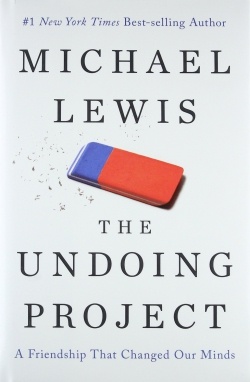 Book
Book
Lewis, Michael. “The Undoing Project: A Friendship that Changed our Minds.” (2016). WW Norton & Co.
Reviewer
Dr. Scott Downey, Associate Director and Professor
Summary
Michael Lewis (who wrote “Moneyball” and “The Big Short”) presents this terrific story of the friendship and academic rivalry between Daniel Kahneman and Amos Tversky. It is an easy read but provides a substantive context for the foundations of behavioral economics. Lewis presents these two great minds in contrast. Tversky was optimistic and confident and Kahneman self-doubting and pessimistic. While Tversky was receiving attention, Kahneman was challenged to find his own voice. Both go on to receive Nobel-level accolades. While we learn about these two men and their impacts, we also learn about behaviorism (my field) and how it relates to economics. From their work in understanding why the Israeli military would repeatedly promote the wrong soldiers to the many examples of how humans often draw the wrong conclusions, the book is a fascinating look into how we make decisions and the biases or tricks that lead us there.
What this means for food and agribusiness
We do not always make decisions rationally—not managers, not salespeople, not customers. Human beings are terrible judges of attribution, or causality. We—academics included—are often overconfident and take mental shortcuts, overlooking facts in favor of opinion. Understanding these pitfalls can be a useful reminder that things are not always as they appear.
One example of this is called the “availability” heuristic. When we have seen information repeatedly, we tend to assume that observations are caused by that fact. This concept has shaped much of my approach to discovery that we teach to salespeople. The idea is that sellers who constantly run into customers with similar problems tend to then look for those same problems. The analogy would be that a doctor who sees sneezing patients with colds all day long tends to assume that the next sneezing patient probably has a cold. This works really well. It is efficient and may be correct most of the time, except when the patient actually has allergies. There are all kinds of repercussions of this. Sales managers who are promoted into management because they were good salespeople tend to assume they know how to sell. As a result, many sales managers try to get salespeople to sell the way they did. Salespeople who are successful with their customers assume they know how to sell and approach each customer using the approach that they believe works. Both may be true. The manager and salesperson do know how to sell, but only to their customers. There is an entire set of customers who didn’t buy from them. The approach that works for one salesperson may not be the best approach for another.
Another example of their work is the theory of loss aversion. This says that people will make irrational choices in order to avoid the possibility of loss. Buyer behavior often is influenced by this factor. It is why marketers can explain rational reasoning that one product is superior to another all day long without persuading customers to make a change. A new product has inherent risk as compared to a comfortable tried and true product. This goes further into our own behavior change. We are likely to continue to pursue a “safe” way of doing things than to change what we do and receive a “potential” reward.
Kahneman and Tversky took the approach that the best way to look at human behavior was to measure actual behavior rather than just to ask questions. Measuring actual behavior helps find inconsistencies between what someone says is important to them and the way they actually act. I may, for example, say I want to lose weight, but I eat pie whenever I get the chance. The parallel in the sales area is that a customer may want to improve their yield, rate of gain, or production; but every time they have an opportunity to spend less for a product they do. Both can be true. Humans do not have to be rational. We have the ability to both want to improve and to save and we can want to lose weight and want to eat pie. Which one of these contrasting goals wins may depend on the moment. My ability to judge whether pie or weight loss wins most frequently is very poor. Liking pie more than wanting to lose weight is irrational. To admit to myself or others that I like pie more than losing weight might make me look bad, or face that I’m not who I want to be. Rather than do that, I will always say that my goal is to lose weight. Customers may say they want to improve performance, but their actions always take them a different direction. The lesson for sellers is that often today our job is helping the customer measure. Work with them to identify the inputs that lead to the outcomes they want. It’s like helping them measure the 10,000 steps they must take each day in order to get fit, except that our focus is on helping them measure the smaller steps that will help them achieve their business goals.
There are numerous other examples in “The Undoing Project” that describe how humans make errors in judgment. Many of them are predictable. I highly encourage reading this book.




